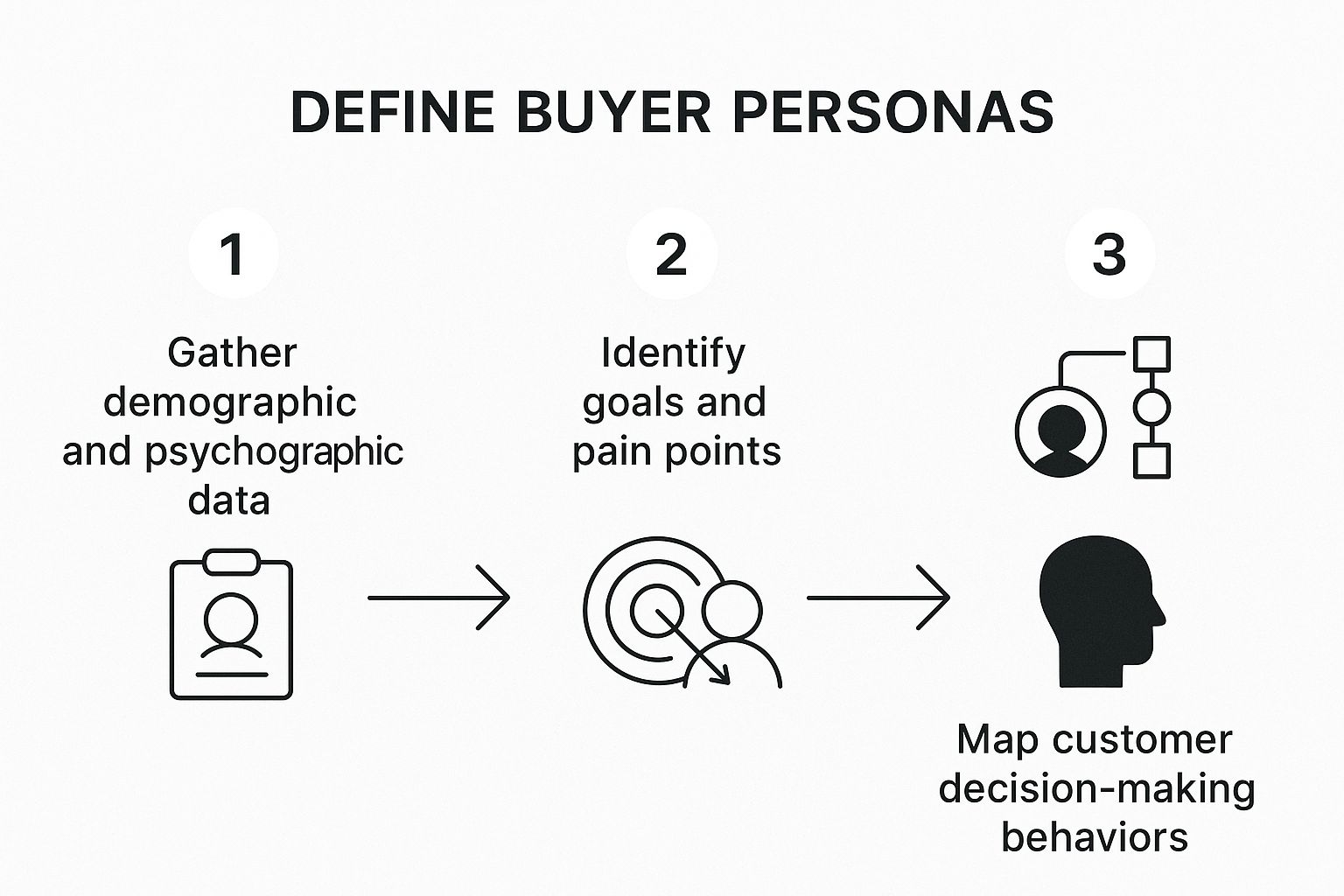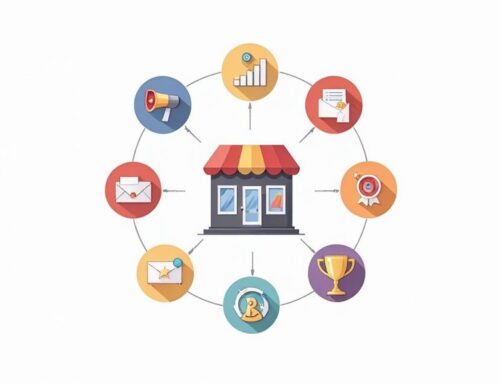At its core, creating a buyer persona is a straightforward idea. You research your audience, look for patterns in their goals and behaviors, and then build a detailed profile that makes all that data feel human. This profile becomes a stand-in for your ideal customer, a fictional character who steers your entire strategy.
Why Buyer Personas Are a Growth Multiplier

Let’s get past the textbook definitions for a minute. In the real world, deeply understanding your customer isn’t just a nice-to-have; it’s the bedrock of any sustainable growth. It’s one thing to think you know your audience, but it’s another thing entirely to actually know them based on solid, real-world data. That’s what separates the brands that thrive from those that just get by.
When done right, a buyer persona acts like a strategic compass for your entire company. It gets your marketing, sales, and product development teams all pointing in the same direction, focused on a single, clear picture of your customer. When everyone shares that vision, the customer experience becomes seamless and far more effective.
Fostering Cross-Functional Alignment
Have you ever seen it happen? The sales team hears one set of problems on their calls, while the marketing team is creating content that addresses a totally different set of challenges. It’s a classic disconnect that wastes time, money, and sends confusing messages to the market.
This is exactly what personas are designed to fix. They create a shared language.
For instance, if “Marketing Mary” is one of your key personas, your product team immediately knows she’s desperate for features that save her time. At the same time, your sales team knows her biggest hesitation is budget constraints, and your content team can get to work creating case studies that prove ROI. Suddenly, everyone is working together, and that unified approach is incredibly powerful.
It’s not just a hunch. A compelling study revealed that 90% of companies using buyer personas reported a clearer understanding of their customers. This is the insight that truly unlocks alignment.
This isn’t just about feeling more in tune with your audience. It translates directly into better business outcomes, allowing your teams to identify and engage the right people much earlier in their buying journey. You can dig into the full report on how personas improve consumer understanding on Delve.ai.
The Impact of Well-Defined Buyer Personas
The positive effects of solid personas ripple throughout the entire organization. They turn vague strategies into concrete actions. When every team is working from the same playbook about who they’re serving, their efforts become so much more impactful. This is how you stop shouting into the void and start building genuine relationships.
The table below breaks down just how much value these detailed profiles can create across different parts of your business.
The Impact of Well-Defined Buyer Personas
| Business Area | Benefit of Using Buyer Personas |
|---|---|
| Marketing | Develops highly-targeted content and campaigns that speak directly to specific pain points and motivations. |
| Sales | Improves lead qualification and fosters more personalized, empathetic conversations that address core needs. |
| Product Development | Guides the feature roadmap by prioritizing updates that solve real-world problems for the target user. |
| Customer Support | Provides crucial context for customer issues, leading to faster, more effective solutions and higher satisfaction. |
Ultimately, investing in buyer personas is the first step toward building a truly customer-centric culture. It forces every decision, from a new ad campaign to a minor product tweak, to start with one simple but critical question: “What would our customer think of this?” That mindset is what drives lasting loyalty and real, sustainable growth.
Gathering Your Data the Right Way

Creating a buyer persona that actually works means you’re collecting the right demographic and psychographic data, figuring out what your customers are trying to achieve, and understanding what makes them tick. The infographic above breaks down this journey, showing you how to turn a mountain of raw information into real, usable insights.
Solid personas are built on truth, not guesswork. This is the part where you have to roll up your sleeves and dig into some real, hard data. It might sound like a lot of work, but this research phase is where you’ll find the golden nuggets that make your personas powerful. Let’s leave assumptions at the door and go find some facts.
The best place to begin is with the people who have already bought from you. Your existing customer base holds the key.
Digging for Internal Data
Your first stop should be your own backyard—your internal systems. Your CRM is an absolute treasure trove of information just waiting to be explored. Start sifting through it to find patterns in job titles, company sizes, and industries that are common among your best customers.
But don’t just stop at the data. Go talk to the people on the front lines: your sales and customer support teams. These folks talk to customers all day, every day. They have an almost intuitive grasp of customer pain points, the questions that come up constantly, and those “aha!” moments that close a deal.
Set up a few quick, casual chats with them. Ask questions like:
- What are the most frequent objections you have to overcome on sales calls?
- Which features get our happiest customers the most jazzed?
- What problem is someone usually trying to fix when they first contact us?
Their answers will give you the kind of rich, qualitative context that rows of data in your CRM just can’t provide. This mix is what you need for a truly fleshed-out persona.
Conducting Customer Interviews and Surveys
Internal data gives you a great head start, but there’s no substitute for talking directly to your customers. This is where you uncover their deep-seated motivations, their day-to-day frustrations, and what “success” actually means in their world.
Try to interview a good mix of people—not just your biggest fans, but also customers who may have hit a few bumps along the way. The goal isn’t to fish for compliments; it’s to understand their complete journey. For broader insights, a simple, well-designed survey can help you gather data from a much larger group.
Here’s a pro tip for your interviews: always ask open-ended questions. Instead of asking, “Does our software save you time?” (a simple yes/no), try this: “Can you walk me through how you used to handle this task before our software, and how you do it now?”
This simple shift encourages people to tell a story, revealing all the little details that will make your persona feel like a real person. To keep all this information organized, using a customer persona template and a good guide can make a world of difference.
From Raw Data to a Compelling Persona Story

So, your research is done. You’re now staring at a mountain of interview notes, survey results, and analytics. It’s valuable stuff, but it’s also a mess. The real trick is to take these scattered data points and shape them into a character that feels like a real person—someone your team can actually understand and rally behind.
This isn’t about just creating a slide with a list of facts. It’s about storytelling. You’re building a narrative that gives this persona a personality, making them more than a collection of stats. When a persona feels human, it becomes an incredible tool for building empathy and making smarter decisions.
Building the Persona’s Foundation
Let’s start with the basics to give your persona a solid identity. This framework is the at-a-glance context your team needs to get a feel for who this person is.
Your foundational elements should include:
- A Name and Photo: First, give your persona a name. Alliterative names like “Marketing Manager Molly” or “Startup Steve” are catchy and easy to remember. Then, find a stock photo that feels like a genuine representation of this person. It’s a simple step, but it makes the persona instantly more human.
- Key Demographics: Nail down the core details. Think age, job title, company size, and maybe a general location. These facts ground your persona in a realistic professional world.
- Professional Context: Briefly sketch out their career journey and what they’re responsible for in their current role. What does a typical day look like for them?
This initial structure sets the stage, but the real story—the part that matters—comes from digging into what makes them tick.
Articulating Goals and Challenges
This is the heart and soul of your persona. What drives this person forward? And what keeps them up at night? This is where you put all that rich, qualitative data from your interviews to work. Your job is to pinpoint their main goals and the biggest obstacles getting in their way.
“Personas need to be more than just a summary of who buys from you. They should be a story about why they buy from you. The best personas capture the ‘before’ and ‘after’—the problem they face and the solution they seek.”
For instance, don’t just say your persona is “busy.” That’s too generic. Get specific. Describe their struggle: “Struggles to prove the ROI of her marketing spend to a skeptical leadership team.” That one detail gives your sales and marketing teams a concrete problem to solve. Weaving this level of detail into your larger data-driven marketing strategy ensures your messaging hits home.
This focused approach isn’t just about better alignment; it has a real impact on the business. When you get this right, you can boost client retention by 14% and see revenue growth of 19%, according to research highlighted by Forms.app.
To make the story truly come alive, pepper it with direct quotes from your customer interviews. A real snippet like, “I spend half my Monday just pulling reports,” is far more powerful than a bland bullet point that says “Wants to save time.” These are the details that turn a flat profile into a three-dimensional character your team will actually want to help.
Getting a Second Opinion: How to Validate and Refine Your Personas
It’s easy to get attached to the personas you’ve just built. But creating them in isolation is a classic misstep. If you don’t check your work, you might end up with an imaginary friend for your marketing team instead of a true-to-life profile of your customers. The whole point of this next phase is to stress-test your assumptions and make sure your hard work actually connects with reality.
Think of your first persona document as a rough draft. It’s a great starting point, but it’s not finished until it’s been vetted by the people who know your customers best.
Gut-Check Your Work with Internal Teams
Who talks to your customers all day, every day? Your sales and customer support teams. They’re sitting on a goldmine of firsthand knowledge about your audience’s real-world problems and motivations.
Don’t just email your draft and hope for a reply. Pull key people from those teams into a quick, informal meeting. Walk them through the persona’s story and see how it lands.
Get specific with your questions:
- “Does this actually sound like the people you talk to?”
- “What’s the one big challenge we missed that always comes up on calls?”
- “Is their ‘day in the life’ realistic, or does it feel made up?”
Their answers will instantly show you where your research might have gone off track. For instance, you might have concluded a persona loves cutting-edge tech, but your sales reps know they really care about cost savings and proving immediate ROI. That’s the kind of invaluable insight that makes your persona truly useful.
Validation isn’t about getting a pat on the back. You want your colleagues to poke holes in your work. Finding those gaps now means you can fix them before you build an entire marketing strategy on a shaky foundation.
Test Your Personas Against Real Customers
After your persona has made it past your internal experts, it’s time for the final boss: your actual customers. The best way to do this is by sharing a simplified version with a small group of clients you have a good relationship with.
You don’t need to send them the full, detailed document. Frame it as asking for their expert opinion. A simple outreach can work wonders: “We’re working to better understand professionals like you. Does this general profile of goals and challenges ring true based on your own experience?”
This approach is powerful for two reasons. First, it’s the ultimate validation from the source of truth. Second, it shows your customers that you care about their world, making them feel valued and strengthening that relationship.
This final check ensures your personas are more than just a clever exercise. It grounds them in the real world, turning them into a reliable guide for everything you do next.
Putting Your Buyer Personas Into Action

It’s one thing to have a beautifully designed set of buyer personas. It’s another thing entirely to use them. A persona document that just sits on a server collecting digital dust is, frankly, useless. The real magic happens when your personas start guiding the decisions your teams make every single day.
The goal here is to shift from just knowing your customer to actively serving them based on that knowledge. Think of your personas as the starting point for every campaign, sales call, and product update. They need to become a living, breathing part of your company culture, not just a one-off marketing project.
Weaving Personas into Your Marketing
Let’s get down to brass tacks. In content marketing, a persona like “Startup Founder Sam” gives your writers a clear direction. Instead of churning out a generic post on business growth, they can craft something laser-focused, like “How Bootstrapped Founders Can Secure Their First Seed Round.” This speaks directly to Sam’s specific financial anxieties and ambitions.
The same principle applies to your email marketing. Why send a one-size-fits-all newsletter when you can segment your list by persona? Sam gets an email highlighting a case study from a similar startup, while “Corporate Manager Maria” receives a whitepaper on boosting team efficiency. This is the kind of targeted approach at the heart of effective inbound marketing and lead generation.
Key Takeaway: Don’t underestimate the impact. Websites that are carefully tailored using marketing personas can become 2 to 5 times more effective and easier for your ideal customers to navigate.
When you integrate personas this deeply, your marketing stops shouting into the void and starts having meaningful conversations about the problems your audience actually cares about.
Fueling Sales and Product Development
Your personas shouldn’t be confined to the marketing department. They are incredibly powerful tools for your sales and product teams, too.
A well-defined persona gives your sales reps a vivid picture of who they’re talking to before they even dial the number. They can anticipate objections, understand what truly motivates that person, and tailor their pitch to solve a specific, real-world problem.
For product development, personas are your North Star. When your team is debating which features to prioritize, the conversation should be grounded in reality. Instead of guessing, they should be asking, “What would ‘Startup Founder Sam’ find most valuable?” or “What feature would solve ‘Corporate Maria’s’ biggest daily frustration?”
This continuous, cross-departmental use is what separates the high-performers from everyone else. The data doesn’t lie: over 60% of companies that refreshed their buyer personas within the last six months blew past their lead generation and revenue goals. It pays to keep them fresh and active.
To make this more tangible, let’s look at how personas can be applied across different parts of your business.
Persona Application Across Departments
The table below offers a practical guide, showing how various teams can leverage buyer personas to sharpen their focus and contribute to shared business goals.
| Department | Primary Use Case | Expected Outcome |
|---|---|---|
| Content Marketing | Topic ideation and messaging | Higher engagement and more relevant content that attracts the right audience. |
| Email Marketing | List segmentation and personalization | Increased open rates, click-through rates, and targeted lead nurturing. |
| Sales | Lead qualification and call preparation | More empathetic conversations and a sales process focused on solving specific needs. |
| Product Development | Feature prioritization and roadmap | A product that evolves to meet genuine customer problems and increases user satisfaction. |
Ultimately, integrating personas requires a conscious, ongoing effort. But by making them a central part of your strategy, you ensure every team is pulling in the same direction—toward a deeper, more authentic connection with your customers.
Answering Your Top Questions About Buyer Personas
When you first start digging into buyer personas, a few questions always pop up. It’s totally normal. Getting these sorted out from the beginning helps you build something genuinely useful instead of just another document that sits on a shared drive.
Let’s walk through some of the most common hurdles I see teams run into.
How Many Personas Is Too Many?
This is usually the first question on everyone’s mind: “So, how many of these do we actually need?” There isn’t a single magic number, but the goal here is focus, not a headcount.
For most businesses, starting with one to three core personas is the sweet spot. It’s manageable. It gives your team something tangible to work with without overwhelming them with a dozen different personalities to memorize.
Think about it. If you roll out ten personas at once, are your sales and marketing teams really going to remember the nuances of each? Probably not. It’s far more effective to have a couple of deeply understood personas that everyone on the team can name and describe than a long list that nobody ever looks at.
Persona vs. Ideal Customer Profile: What’s the Difference?
Here’s another point that trips people up: the distinction between a buyer persona and an Ideal Customer Profile (or ICP). They sound alike, and they’re related, but they serve two very different functions.
- An Ideal Customer Profile (ICP) is about the company. It’s a high-level look at the perfect organization to sell to, focusing on things like industry, employee count, annual revenue, and geographic location. It answers the question, “What type of business gets the most value from our solution?”
- A Buyer Persona is about the people inside that ideal company. This is where you get personal. You’re diving into the goals, daily frustrations, motivations, and job responsibilities of the individuals who will champion, purchase, or use your product.
Here’s an easy way to remember it: Your ICP helps you find the right building to walk into. Your buyer personas introduce you to the people you need to talk to once you’re inside.
How Often Should We Update Our Personas?
Finally, let’s talk about shelf life. Your personas aren’t a “set it and forget it” project. They need to evolve right along with your customers and the market.
As a general guideline, plan to review and refresh your buyer personas at least once a year. That’s a solid baseline.
However, some events should trigger an immediate update. Be ready to revisit them if you see:
- A significant pivot in your product or services.
- A move into a brand new market or industry.
- A clear shift in customer feedback, buying habits, or pain points.
Treating your personas like living documents is what keeps them relevant and powerful. An annual check-in ensures your marketing and sales strategies don’t become stale, keeping them aligned with the real people you’re trying to connect with.
Ready to build a strategy that truly resonates with your ideal customers? The team at ReachLabs.ai combines data-driven insights with world-class talent to elevate your brand. We specialize in creating tailored digital campaigns that drive real results. Discover how our collective approach can transform your marketing.





